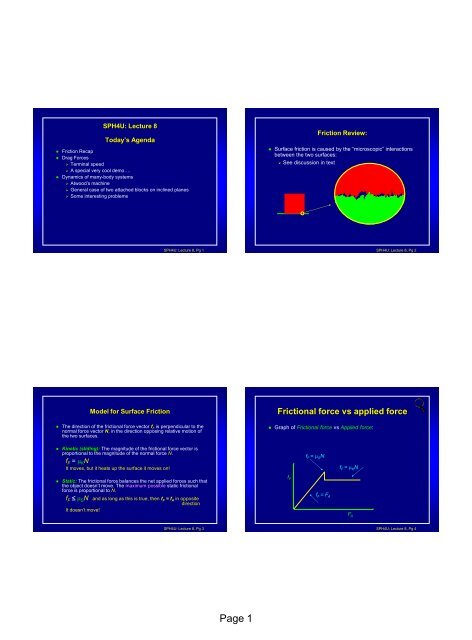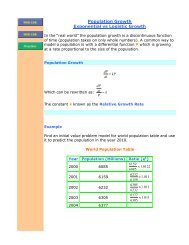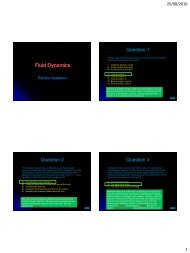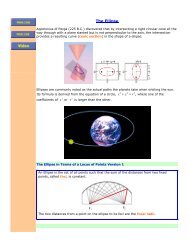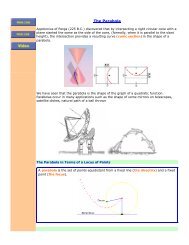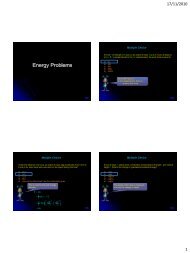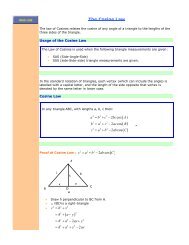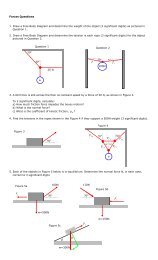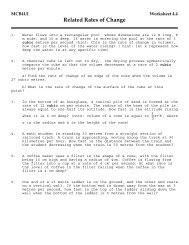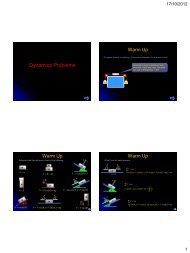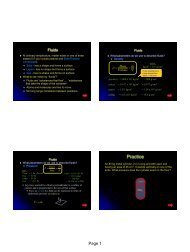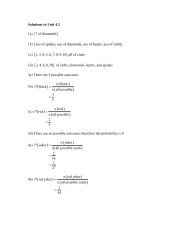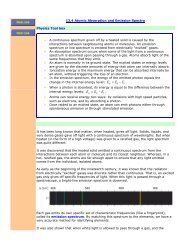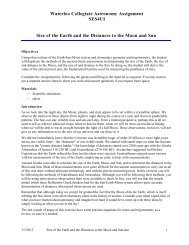SPH4U: Lecture 8 Notes - The Burns Home Page
SPH4U: Lecture 8 Notes - The Burns Home Page
SPH4U: Lecture 8 Notes - The Burns Home Page
- No tags were found...
Create successful ePaper yourself
Turn your PDF publications into a flip-book with our unique Google optimized e-Paper software.
<strong>SPH4U</strong>: <strong>Lecture</strong> 8Today’s Agenda• Friction Recap• Drag Forces‣ Terminal speed‣ A special very cool demo….• Dynamics of many-body systems‣ Atwood’s machine‣ General case of two attached blocks on inclined planes‣ Some interesting problemsFriction Review:• Surface friction is caused by the “microscopic” interactionsbetween the two surfaces:‣ See discussion in text<strong>SPH4U</strong>: <strong>Lecture</strong> 8, Pg 1<strong>SPH4U</strong>: <strong>Lecture</strong> 8, Pg 2Model for Surface Friction• <strong>The</strong> direction of the frictional force vector f F is perpendicular to thenormal force vector N, in the direction opposing relative motion ofthe two surfaces.Frictional force vs applied force• Graph of Frictional force vs Applied force:• Kinetic (sliding): <strong>The</strong> magnitude of the frictional force vector isproportional to the magnitude of the normal force N.f F = K NIt moves, but it heats up the surface it moves on!f F = S Nf F = K N• Static: <strong>The</strong> frictional force balances the net applied forces such thatthe object doesn’t move. <strong>The</strong> maximum possible static frictionalforce is proportional to N.f F S N and as long as this is true, then f F = f A in oppositedirectionIt doesn’t move!f Ff F = F AF A<strong>SPH4U</strong>: <strong>Lecture</strong> 8, Pg 3<strong>SPH4U</strong>: <strong>Lecture</strong> 8, Pg 4<strong>Page</strong> 1
Kinetic Friction:draw a free body diagram, and follow the rules!• K is the coefficient of kinetic friction.i : F K N = maj : N = mgso F K mg = maStatic Friction:• <strong>The</strong> “coefficient of static friction,” S , determines maximumstatic frictional force, S N, that the contact between the objectscan provide.• S is discovered by increasing F until the object starts to slide:F MAX - S N = 0 N = mg (in this case)F MAX = S mg S F MAX / mgNjNjFmaiF MAXi K Nmg S Nmg<strong>SPH4U</strong>: <strong>Lecture</strong> 8, Pg 5<strong>SPH4U</strong>: <strong>Lecture</strong> 8, Pg 6<strong>Lecture</strong> 8, Act 1friction dynamics• A block of mass m, when placed on a rough inclined plane( > 0) and given a brief push, keeps moving down the plane withconstant speed.‣ If a similar block (same ) of mass 2m were placed on the sameincline and given a brief push, it would:m(a)stop(b) accelerate(c) move with constant speed<strong>Lecture</strong> 8, Act 1Solution• Since the velocity is constant, it’s just broken free from S. F.‣ Net force down ramp is essentially zero• Draw FBD and find the total force in the x-directionF NET,X = mg sin q K mg cos qji K NNqmgmg sinq= ma = 0 (first case)qDoubling the mass will simplydouble both terms…net forcewill still be zero!Speed will still be constant!Increase the friction and thedownhill force by the samefactor nothing changes!<strong>SPH4U</strong>: <strong>Lecture</strong> 8, Pg 7<strong>SPH4U</strong>: <strong>Lecture</strong> 8, Pg 8<strong>Page</strong> 2
Friction in Fluids: Drag Forces• When an object moves through a viscous medium, like air orwater, the medium exerts a “drag” or “retarding” force thatopposes the motion of the object relative to the medium.Many-body Dynamics• Systems made up of more than one object• Objects are typically connected:F DRAG‣ By ropes & pulleystoday‣ By rods, springs, etc.later onvF g = mgj<strong>SPH4U</strong>: <strong>Lecture</strong> 8, Pg 9<strong>SPH4U</strong>: <strong>Lecture</strong> 8, Pg 10Atwood’s Machine:Masses m 1 and m 2 are attached to an ideal massless stringand hung as shown around an ideal massless pulley.Atwood’s Machine...• Draw free body diagrams for each object• Applying Newton’s Second Law: ( j -components)• What are the tensions in thestring T 1 and T 2 ?• Find the accelerations, a 1 anda 2 , of the masses.• Use FBD• Solve for motion• You’re a hero!Fixed Pulleyjma 11m a 22‣ T 1 - m 1 g = m 1 a 1‣ T 2 - m 2 g = m 2 a 2Yikes! 2 eqn, but 4 unk???But T 1 = T 2 = Tsince pulley is idealand a 1 = -a 2 = -a.since the masses areconnected by the stringFree Body DiagramsT 1 T 2aj1 a 2T 1T 2<strong>SPH4U</strong>: <strong>Lecture</strong> 8, Pg 12m 1 gm 2 g<strong>SPH4U</strong>: <strong>Lecture</strong> 8, Pg 11<strong>Page</strong> 3
m 1 g - T = m 1 a (a)T - m 2 g = m 2 a (b)• Two equations & two unknowns‣ we can solve for both unknowns (T and a).• Add (b) + (a):‣ g(m 1 - m 2 ) = a(m 1 + m 2 )(m1- m2)‣ a =g(m1+ m2)• Subract (b) - (a):2(m1- m2)‣ 2T - g(m 1 + m 2 ) = -a(m 1 - m 2 ) = - gm1+ m2‣ Use polynomial arithmetic…‣ T = 2gm 1 m 2 / (m 1 + m 2 )Atwood’s Machine...aFree Body DiagramsTm 1 gTam 2 g• So we find:m ma ( 1 2 )( m m )g1 22 m1m2T = g(m + m )12Atwood’s Machine...aTm1Tm2ja<strong>SPH4U</strong>: <strong>Lecture</strong> 8, Pg 13<strong>SPH4U</strong>: <strong>Lecture</strong> 8, Pg 14Is the result reasonable?Check limiting cases!m ma ( 1 2 )( m m )g1 22 m m1 2T g( m m )12A related situation:Attached bodies on two inclined planessmooth peg• Special cases:i.) m 1 = m 2 = m a = 0 and T = mg. OK!ii.) m 2 or m 1 = 0 |a| = g and T= 0. OK!m 1m 2• Atwood’s machine can be used to determine g (bymeasuring the acceleration a for given masses).(m2 m1)g =+ a(m2- m1)If m 1 is almost m 2 , then acceleration will be small.You can measure motion for a long time. More accurate….<strong>SPH4U</strong>: <strong>Lecture</strong> 8, Pg 15q 1 q 2all surfaces frictionlesspeg is frictionless<strong>SPH4U</strong>: <strong>Lecture</strong> 8, Pg 16<strong>Page</strong> 4
How will the bodies move?From the free body diagrams for each body, and the chosencoordinate system for each block, we can apply Newton’sSecond Law:Taking “x” components:1) T 1 - m 1 g sin q 1 = m 1a 1X2) T 2 - m 2 g sin q 2 = m 2 a 2XBut T 1 = T 2 = Tand -a 1X = a 2X = a(constraints)yNm 1m 1 gq 1xT 1T 2xm 2 gyNm 2Solving the equationsUsing the constraints, we get 2 eqn and 2 unks,solve the equations.T - m 1 gsin q 1 = -m 1 a(a)T - m 2 gsin q 2 = m 2 a(b)Subtracting (a) from (b) gives:m 1 gsin q 1 - m 2 gsin q 2 = (m 1 +m 2 )aSo:m ma 1 sin q1 2 sin q2gm1 m2q 2<strong>SPH4U</strong>: <strong>Lecture</strong> 8, Pg 18<strong>SPH4U</strong>: <strong>Lecture</strong> 8, Pg 17m 1m 2q 1 q 2m ma 1 sin q1 2 sin q2gm1 m2m m 1 2m ma 1 sin q1 2 sin q2gm1 m2q 1 q 2Special Case 1:Special Case 2:BoringTTAtwood’s Machinem 1m 2If q 1 = 0 and q 2 = 0, a = 0.m1m2If q 1 = 90 and q 2 = 90,m ma ( 1 2 )( m m )g1 2<strong>SPH4U</strong>: <strong>Lecture</strong> 8, Pg 19<strong>SPH4U</strong>: <strong>Lecture</strong> 8, Pg 20<strong>Page</strong> 5
m m 1 2m ma 1 sin q1 2 sin q2gm1 m2q 1 q 2Special Case 3:m 1Lab configurationm 2<strong>Lecture</strong> 8, Act 2Two-body dynamics• In which case does block m experience a larger acceleration?In (1) there is a 10 kg mass hanging from a rope. In (2) ahand is providing a constant downward force of 98.1 N. Inboth cases the ropes and pulleys are massless.mma10kgaF = 98.1 NIf q 1 = 0 and q 2 = 90,ma 2( m m g1 2 )Case (1) Case (2)(a) Case (1) (b) Case (2) (c) same<strong>SPH4U</strong>: <strong>Lecture</strong> 8, Pg 21<strong>SPH4U</strong>: <strong>Lecture</strong> 8, Pg 22a<strong>Lecture</strong> 8, Act 2Two-body dynamics• In which case does block m experience a larger acceleration?In (1) there is a 10 kg mass hanging from a rope. In (2) ahand is providing a constant downward force of 98.1 N. Inboth cases the ropes and pulleys are massless.10kgm W =10kgm(a) Case (1) (b) Case (2) (c) sameamF = 98.1 NCase (1) Case (2)• Add (a) and (b):m W g = (m + m W )amWga m m• Note:W<strong>Lecture</strong> 8, Act 2Solution• For case (1) draw FBD and write F NET = ma for each block:T = ma (a)(a)m W g -T = m W a(b)mT mWg m mWa10kg(b)mm W =10kg<strong>SPH4U</strong>: <strong>Lecture</strong> 8, Pg 23<strong>SPH4U</strong>: <strong>Lecture</strong> 8, Pg 24<strong>Page</strong> 6
<strong>Lecture</strong> 8, Act 2Solution• For case (2) T = 98.1 N = maa98.1Na m 10kg10kgCase (1)m98.1Na m• <strong>The</strong> answer is (b) Case (2) In this case the block experiences alarger acceleratioina98.1Na mmF = 98.1 NCase (2)<strong>SPH4U</strong>: <strong>Lecture</strong> 8, Pg 25Problem: Two strings & Two Masses onhorizontal frictionless floor:• Given T 1 , m 1 and m 2 , what are a and T 2 ?T 1 - T 2 = m 1 a (a)T 2 = m 2 a (b)‣ Add (a) + (b):T1T 1 = (m 1 + m 2 )a a =m1+ m‣ Plugging solution into (b):m2T2= T1m + m12m 2m 1T 2 T 12a<strong>SPH4U</strong>: <strong>Lecture</strong> 8, Pg 26i<strong>Lecture</strong> 8, Act 3Two-body dynamics• Three blocks of mass 3m, 2m, and m are connected bystrings and pulled with constant acceleration a. What is therelationship between the tension in each of the strings?• Draw free body diagrams!!T 3 = 3ma<strong>Lecture</strong> 8, Act 3Solution3mT 3a3mT 3 T 2 T2m1mT 2 - T 3 = 2maT 3 T 2 2mT 2 = 2ma +T 3 > T 3T 2 T 1(a) T 1 > T 2 > T 3 (b) T 3 > T 2 > T 1 (c) T 1 = T 2 = T 3T 1 - T 2 = mamT 1 = ma + T 2 > T 2T 1 > T 2 > T 3<strong>SPH4U</strong>: <strong>Lecture</strong> 8, Pg 27<strong>SPH4U</strong>: <strong>Lecture</strong> 8, Pg 28<strong>Page</strong> 7
• Alternative solution:Consider T 1 to be pullingall the boxesT 2 is pulling only theboxes of mass 3mand 2mT 3 is pulling only thebox of mass 3m<strong>Lecture</strong> 8, Act 3Solution3m3m3maT 3 T 2 T2m1maT 3 T 2 T2m1maT 3 T 2 T2m1miProblem: Accelerometer• A weight of mass m is hung from the ceiling of a car with amassless string. <strong>The</strong> car travels on a horizontal road, andhas an acceleration a in the x direction. <strong>The</strong> string makesan angle q with respect to the vertical (y) axis. Solve for qin terms of a and g.aqT 1 > T 2 > T 3<strong>SPH4U</strong>: <strong>Lecture</strong> 8, Pg 29<strong>SPH4U</strong>: <strong>Lecture</strong> 8, Pg 30Accelerometer...Accelerometer...• Draw a free body diagram for the mass:‣ What are all of the forces acting?qT (string tension)• Using components (recommended):i: F X = T X = T sin q = maj: F Y = T Y mgq= T cos q mg = 0 Tqjimmg (gravitational force)mammgi<strong>SPH4U</strong>: <strong>Lecture</strong> 8, Pg 31<strong>SPH4U</strong>: <strong>Lecture</strong> 8, Pg 32<strong>Page</strong> 8
Accelerometer...Accelerometer...• Using components :i: T sin q = ma• Alternative solution using vectors (elegant but not assystematic):• Find the total vector force F NET :j: T cos q- mg = 0• Eliminate T :T sin q= ma tan q aT cos q= mg gTmaqmmgijmgqTF TOTqT (string tension)mmg (gravitational force)<strong>SPH4U</strong>: <strong>Lecture</strong> 8, Pg 33<strong>SPH4U</strong>: <strong>Lecture</strong> 8, Pg 34Accelerometer...tan q a gAccelerometer...• Alternative solution using vectors (elegant but not assystematic):• Find the total vector force F NET :• Recall that F NET = ma:T (string tension)qT• Somgqmama atan q mg gmmg (gravitational force)tan q a g• Let’s put in some numbers:• Say the car goes from 0 to 60 mph in 10 seconds:‣ 60 mph = 60 x 0.45 m/s = 27 m/s.‣ Acceleration a = Δv/Δt = 2.7 m/s 2 .‣ So a/g = 2.7 / 9.8 = 0.28 .‣ q = arctan (a/g) = 15.6 degaqCart w/accelerometer<strong>SPH4U</strong>: <strong>Lecture</strong> 8, Pg 35<strong>SPH4U</strong>: <strong>Lecture</strong> 8, Pg 36<strong>Page</strong> 9


